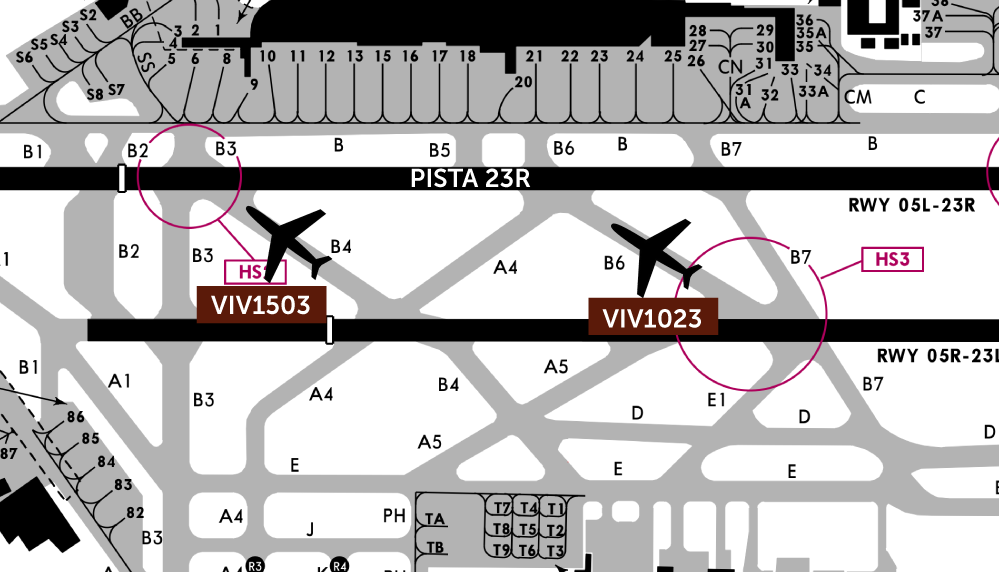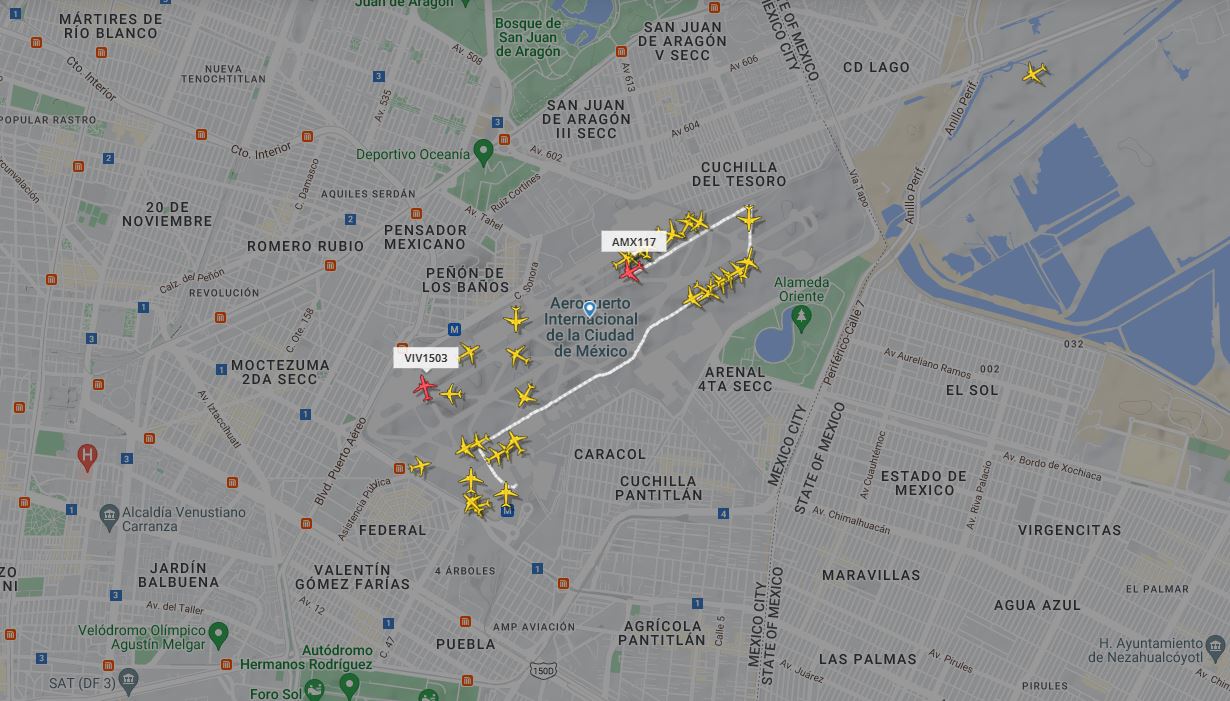Exclusive: Runway Incursion in Mexico City Grows List of Recent Incidents and Deepens Safety Concerns
An Aeroméxico Boeing 737 MAX 8 and a Viva Aerobús Airbus A321 were involved in a serious incident at the Benito Juárez airport in the Mexican capital. The event occurred on May 10 at approximately 21:50 UTC (15:50 local time), when the Viva Aerobús aircraft (flight 1503 arrived from Nuevo Laredo) crossed Ciudad de Mexico’s runway 23R just as the Aeroméxico aircraft (flight 117 bound for Ciudad Juárez) was taking off from it.
The runway incursion forced the 737 pilots to reject their takeoff when, according to the details FlightRadar24 provided to Aviacionline, the aircraft had already exceeded 80 knots (about 150 km/h), which is considered a high-speed Rejected Take Off (RTO).
According to what can be learned from the recording of the air traffic control frequency (available via LiveATC), confusion between the crew of the Viva Aerobús flight 1503 and the aerodrome controller appeared to cause the incident.
Four and a half minutes before the incident sequence starts, flight 1503 had landed on runway 23L, after which air traffic control instructed the crew to vacate the runway on their right, taxi via B4 (“Bravo 4”) and to hold short of runway 23R.
Once flight 1503 (VIV1503) was in the instructed position, the aircraft stood there while the takeoff operations continued on the runway ahead of them. It was then when a second aircraft, Viva Aerobús flight 1023 (VIV1023, an Airbus A321 arriving from Cancún), became involved. After landing on runway 23L, the air traffic controller instructed the crew to also vacate the runway on their right, to taxi via B6 (“Bravo 6”) and to hold short of runway 23R. The apparent problem is that, in this occasion, the air traffic controller seemed to confuse their callsign and she mistakenly called the aircraft that has been waiting to cross the other runway for almost five minutes in B4, which is Aeroenlaces 1503 (Aeroenlaces is the radio callsign for Viva Aerobús aircraft).
In that exact moment, with flight 1503 in B4 and with flight 1023 entering B6, Aeroméxico flight 117 was cleared for takeoff on runway 23R. What the Boeing 737 crew ignored then is that the pilots of VIV1503, who had been patiently waiting in Bravo 4, somehow understood they were cleared to cross the active runway.

Immediately after the takeoff clearance for the Aeroméxico Boeing 737 MAX 8, the crew of the Viva Aerobus Airbus A321 tried to warn of the potentially dangerous situation. “We are crossing the runway,” can be heard on the recording. However, their communication was partially blocked by other simultaneous transmissions on the same frequency.
Seconds later, the tower controller of the Benito Juárez airport notices the conflict when she detects that the Viva Aerobus plane is crossing the very same runway the Aeroméxico 737 is using to take off: “Are you crossing? Hold short… Departing traffic, abort takeoff. Aeroméxico 117, abort takeoff.”

Just after the Aeroméxico plane confirmed its interrupted takeoff, the tower controller seemed to believe there could have been a possible confusion among the crews due to the existence of two planes with similar radio callsigns: the “Aeroenlaces 1503” and the “Aeroenlaces 1023”. In any case, the scare is perceptible in the almost shaking voice of the air traffic controller, who is replaced moments later.
High-speed Rejected Take Off
Luckily, the Viva Aerobús Airbus A321 crossed runway 23R at a sufficient distance from where the Aeroméxico 737 MAX 8 was taking off. That runway, almost 4 kilometres long, and the fact that the Viva Aerobús plane crossed the B4 taxiway (located further than others such as B6 or B7) played in their favor.
Without knowing approximately how far the two planes came close to each other, the International Civil Aviation Organization (ICAO) considers this type of incident (a “runway incursion”) serious and, in fact, when it occurs, it is mandatory for crews not to delete the cockpit voice recorder (CVR) to facilitate the investigation.
In this case, there is also another relevant circumstance: the Aeromexico crew aborted takeoff at speeds in excess of 80 knots, which, in the case of a Boeing 737 MAX 8, is considered a high-speed RTO. According to sources familiar with the incident’s details, the flight crew initially reported that the rejected takeoff had occurred when they were already taxiing at 100 knots on runway 23R.
However, according to the ADS-B data that FlightRadar24 shared with Aviacionline, this happened when the plane was moving through the runway at 82 knots (exactly 151 km/h).
The difference between the registered 82 knots and the speed the pilots reported is that, in this case, they probably applied the braking action manually because the automatic RTO braking system (which applies maximum braking power and therefore, is very aggressive and much more uncomfortable) is activated over 88 knots in all Boeing 737-8s.
Once the plane stopped after aborting takeoff, the crew of Aeroméxico Flight 117 followed the usual protocol, initially returning to the boarding gate and getting a mandatory maintenance check, in which special attention is paid to the brakes because they may have overheated during the maneuver.
Once on the platform, the crew went through the usual paperwork and underwent a medical examination in accordance with the regulations of the Mexican authority, the Agencia Federal de Aviación Civil (AFAC). It was not until almost five hours after the scheduled time that passengers on this flight were able to take off to their destination, Ciudad Juárez.
They flew on the same plane, the Boeing 737-8 with registration N868AM, delivered less than a year ago. The other aircraft, the Viva Aerobus Airbus A321 with registration XA-VBU (which flew for the first time in 2016), continued to operate normally afterwards.
A new chapter in a worrying series of incidents
This new serious incident adds to a worrying list of events in which air safety in Mexico, and more specifically, around the country’s capital, has been called into question in the last year.
The most publicized incident, which set off alarm bells and settled in the country’s political debate, occurred a year ago, on May 7, 2022, when a Volaris Airbus A320 had to perform a late go-around when it was at about to land on runway 05L due to the presence of another plane from the same company on the runway. The incident went viral thanks to the video recorded of a pilot who, days later, Volaris fired.
Just a few days later, another similar incident shocked airport operations, although in this case it did not receive any media coverage. An Aeroméxico Connect aircraft was forced to go around when it was on short final of runway 05L due to the presence of another aircraft on the runway, despite having received clearance to land.
???? Nuevo incidente aéreo en Ciudad de México (MEX).
Este miércoles, el vuelo 2647 de @Aeromexico Connect se vio obligado a frustrar su aproximación en corta final de la pista 05L, tras recibir autorización para aterrizar con la pista ocupada. @AeroviaPodcast pic.twitter.com/z46WEsDB8L
— Mikel A. Alcázar (@mikelalcazar) May 15, 2022
It also went unnoticed that, while the seismic alert was sounded in the Mexican capital on December 11, 2022, the operation of an Air Canada Boeing 737 MAX 8 continued as normal because the crew was also not alerted to the risk that the ground on which it began its takeoff might start shaking a few seconds later.
(1/5) ✈️ ¿Qué pasa si suena la alerta sísmica en pleno despegue? Al parecer, no mucho.
La que ha sonado esta mañana no ha impedido que este 737 MAX 8 continuara su despegue en la 05L del aeropuerto de la Ciudad de #México. Imágenes de @webcamsdemexico + audio de @liveatc. pic.twitter.com/LerttRCNbh
— Mikel A. Alcázar (@mikelalcazar) December 11, 2022
On April 17, 2023, two aircraft staged another serious event at the Benito Juárez airport. An Aeroméxico Boeing 737-800 and a Delta Boeing 757-200 sustained damage after colliding on a taxiway next to runway 23L. The Mexican company’s plane did not fly again until April 29. The American plane has been on the ground ever since. Luckily, no injuries occurred.
Aeromexico B738 (XA-AMO) and Delta Air Lines B752 (N649DL) became involved in a ground collision while taxiing for take-off at Mexico City-Intl AP (MMMX). The 757 was holding at taxiway «H» before crossing runway 23L while the 737 continued at «D» for a departure on runway 23L. pic.twitter.com/TAMfMBMkqx
— JACDEC (@JacdecNew) April 18, 2023
Just a few days before the first of the abovementioned incidents, the International Federation of Air Line Pilots’ Associations (IFALPA) published a safety bulletin recommending crews to load additional fuel on flights to Mexico City «after several incidents involving planes arriving» at the Benito Juárez airport.
As Mexican authorities do not publish statistics on the number of serious incidents that are investigated in that country, it is not possible to know to which incidents IFALPA was referring.
Given this scenario, the concern of air transport professionals in Mexico is obvious. Different voices in the sector have asked the government to increase its efforts so that Mexico recovers its Category 1 from the Federal Aviation Administration (FAA) of the United States, after the country was downgraded to Category 2 back in May 2021.

/https://aviacionlinecdn.eleco.com.ar/media/2023/05/aeromexico-viva-aerobus-incidente-mexico-portada.jpg)
Para comentar, debés estar registradoPor favor, iniciá sesión